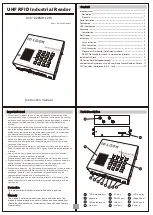
14
ABB i-bus
®
EIB / KNX
Commissioning
Fig. 11: Parameter window “Channel A – Definition of the measuring range”
The following 4 parameters are dependent on the
Send output value
as
parameter. The preset values change depending on which byte value is set.
In addition, the
Factor
parameter appears if the
2-byte [EIB floating point]
or
4-Byte [IEEE floating point]
option is selected.
The following description is an example for all the byte values that can
be set.
Lower measuring limit in x % of the upper limit of effective range
Options: 0...100
Upper measuring limit in x % of the upper limit of effective range
Options:
100...0
These two parameters are used to set the
Lower and upper measuring limit
in x % of the upper limit of effective range
. When the value exceeds or falls
below the set lower and upper measuring limit, the “Measured value outside
range – Channel A” communication object sends a “1”. When the measured
value is between the two limits again, the communication object sends a “0”.
What is the upper limit of effective range?
The upper limit of effective range is the maximum voltage, current, resis-
tance or temperature value which is set in the “Sensor output” parameter,
e.g. a sensor with a signal output of 0 – 10 V has an upper limit of effective
range of 10 V.
3.2.2.1 Definition of
the measuring range
















































